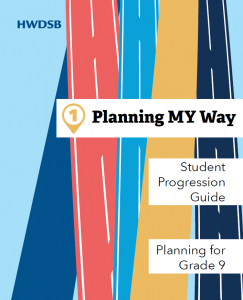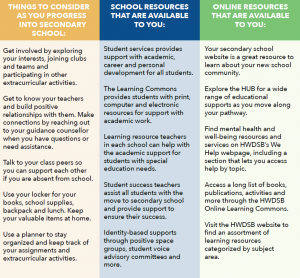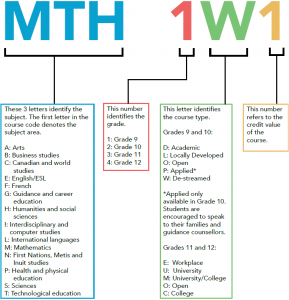
 Your journey into secondary school is an exciting time! You will have the opportunity to participate in, learn from and connect with new activities and people. At HWDSB, we strive to ensure that every student experiences a sense of belonging and engages in dynamic learning to reach their potential and build their own future.
Your journey into secondary school is an exciting time! You will have the opportunity to participate in, learn from and connect with new activities and people. At HWDSB, we strive to ensure that every student experiences a sense of belonging and engages in dynamic learning to reach their potential and build their own future.
Education and career/life planning helps students develop the knowledge and skills they need to make informed choices for their education, career and life outside school. Students get a chance to learn more about themselves and their opportunities, set goals and make plans to achieve them.
HWDSB schools provide opportunities and supports for all students to plan their individual pathways and make a successful transition to their initial post-secondary destination. The five pathways are: Apprenticeship, College, Community, University and Workplace. Click here to learn more about post-secondary pathways.
Grade 9 at HWDSB
Instead of asking you to choose a pathway before entering secondary school, de-streamed Grade 9 keeps all your pathways open! By dismantling barriers and providing equitable opportunities, Grade 9 programming now increases student engagement and learning for all.
| De-streamed Courses | Single-Streamed Courses (Academic Curriculum) | Open Subject Areas |
|
|
|
Grade 9 Open Core French Course: FSF1O
This introductory course provides students who have little or no knowledge of French, or who have not accumulated the minimum of 600 hours of elementary Core French instruction, the opportunity to earn their compulsory French credit.
Grade 9 French Immersion courses will be available as Academic courses for some subjects and Open courses for other subjects. Secondary French Immersion programming is available at Sherwood and Westdale.
Course Substitution
In special circumstances, substitutions may be made at the secondary school principal’s discretion in consultation with secondary team. Substitutions should be made to promote or enhance student learning, or to respond to special needs and interests.
Which Courses do I take in Grade 9?
It is important that you select your Grade 9 courses based on your strengths and interests. In Grade 9, you will take a total of 8 courses: 5 compulsory courses and 3 optional courses.
| Compulsory Courses in Grade 9 | Optional Courses in Grade 9 May Include |
|
|
 Typically, students in Grade 9 take English, mathematics, science, geography, and French. They select 3 additional courses which may include physical education, drama, visual arts, music, technology, business, or social science.
Typically, students in Grade 9 take English, mathematics, science, geography, and French. They select 3 additional courses which may include physical education, drama, visual arts, music, technology, business, or social science.
We encourage students to make informed choices. Taking academic courses in Grade 10 keeps the widest number of options and post-secondary opportunities open. If you are uncertain about courses, contact your secondary school’s student services department for assistance.
Types of Courses in Grades 9 & 10
SINGLE-STREAMED COURSES (Academic Curriculum, Grade 9)
These courses concentrate on fundamental concepts and emphasize theoretical applications while incorporating practical ones when necessary. These courses help students develop your knowledge and skills in the subject.
DE-STREAMED COURSES (Grade 9)
You will take 3 de-streamed courses in Grade 9: Math (MTH1W), Science (SNC1W), and English (ENL1W). These courses are taken by all students as they prepare you for your preferred academic pathway
OPEN COURSES (Grade 9 and 10)
Open courses at the Grade 9 and 10 levels have a single set of expectations for a subject. They are suitable for all students and do not have a particular post-secondary destination.
LOCALLY DEVELOPED COURSES (Grade 9 and 10)
These courses review and reinforce elementary-level curriculum expectations to provide the necessary skills for further study at the secondary level. These courses lead to workplace pathway courses in grades 11 and 12.
APPLIED COURSES (Grade 10)
Applied courses in Grade 10 develop knowledge and skills by emphasizing practical applications of essential concepts while incorporating theoretical applications. They lead to college-level courses in Grade 11 and 12.
ACADEMIC COURSES (Grade 10)
Academic courses in Grade 10 develop knowledge and skills by emphasizing theoretical applications of essential concepts while incorporating practical applications. They lead to university or college-level courses in Grade 11 and 12.
Grade 9 Course Codes
Courses use a 6-character course code for identification. The first 5 characters of the course code are set out by the Ministry of Education. The sixth character is used by school boards to identify a specific characteristic of the course.
Grade 8 to 9 Progression Timeline
| October | Individual Pathway Planner for students in grades 7 and 8
Guidance counsellor visits and in-school pathway presentations with students in Grade 9 |
| November | Grade 7 & 8 Information Nights: Learning more about secondary schools |
| December | Pathways Program Nights: Individual school programs and pathways nights (Co-op, Dual Credit, OYAP, SHSM and special programs)
Initial elementary and secondary student progression meetings |
| January | Course selection nights and school-based information sessions |
| February and March | Course selection process |
| April and May | Final elementary and secondary student progression meetings |
| July and August | Students can begin to earn Community Involvement Hours once Grade 8 is completed |
| August and September | Grade 9 orientation days |
Ontario Secondary School Literacy Test (OSSLT)
The literacy requirement is mandatory for obtaining an OSSD. In Grade 10, you are expected to take the Ontario Secondary School Literacy Test (OSSLT). The OSSLT is based on the literacy expectations until the end of Grade 9. Click here to learn more about the OSSLT.
You will need to meet the provincial standard (Level 3) to pass the test and satisfy the OSSD requirement. To prepare for the OSSLT, you should visit eqao.com for practice assessments and information. Attending school-hosted learning or practice sessions is also encouraged.
Grade 9 EQAO Assessment of Mathematics
Grade 9 students are required to participate in the province-wide Grade 9 Assessment of Mathematics either in January or June, depending on the semester in which you take Mathematics.
The assessment is administered over two consecutive math periods, which usually total two hours. 10% of your final grade is determined by your EQAO score, but it is not graduation requirement.
Students enrolled in locally developed Grade 9 courses are not required to participate in the Assessment of Mathematics.
Plan Your Way
Check out the following links to learn more about the programs, supports and resources available at HWDSB secondary schools.
| Programs | Supports | Resources |
| Programs in Secondary School | Supports in Secondary School | Resources in Secondary School |
Updated on Monday, October 21, 2024.

